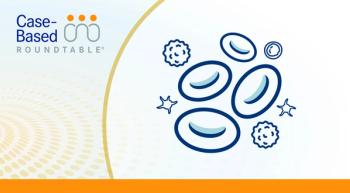
Targeted Therapies in Oncology
- March 2019
- Volume 8
- Issue 4
Significant Increases in Mortality Are Observed With Thrombotic Microangiopathy
In a review of over 300 hematopoietic cell transplantation cases, thrombotic microangiopathy occurred in as many as 36% of patients and significantly raised the risk of related death, according to findings reported at the 2019 Transplantation and Cellular Therapy Meetings.
In a review of over 300 hematopoietic cell transplantation (HCT) cases, thrombotic microangiopathy occurred in as many as 36% of patients and significantly raised the risk of related death, according to findings reported at the 2019 Transplantation and Cellular Therapy Meetings.1
A retrospective application of both the Jodele2and the Cho3diagnostic criteria was used to determine the prevalence and outcomes of transplant-associated thrombotic microangiopathy (TA-TMA), determine whether this condition is independently associated with transplant-related mortality (TRM), and identify features associated with TRM in these patients. Diagnosis by either criteria was associated with worse overall survival (OS).
Additionally, elevated lactic acid dehydrogenase (LDH) and increasing number of antihypertensive medications correlated with worse outcomes among patients with TA-TMA.
“TMA is a frequent complication of both allogeneic and autologous transplantation,” said Michelle Long Schoettler, MD, of Dana-Farber/Boston Children’s Hospital in Massachusetts. “TMA, by either diagnostic criteria, is associated with decreased OS and increased TRM. We propose that [clinical findings of] LDH ≥2 times the upper limit of normal [ULN] or 2 or more antihypertensive medications… may aid providers who do not have complement studies that can have results quickly.”
TA-TMA complicates about 30% of HCT procedures and confers a mortality risk in excess of 50%. The condition is a diagnostic challenge and, in most cases, a clinical diagnosis.
Two sets of diagnostic criteria for TA-TMA have been published. By the Cho criteria, a probable diagnosis requires the presence of schistocytes, increased LDH, thrombocytopenia or need for platelet transfusion, anemia or need for red blood cell transfusion, and a negative Coombs test.2
More recently, Jodele and colleagues proposed alternative TA-TMA diagnostic criteria that included all but the negative Coombs test from Cho, plus age-defined hypertension, proteinuria, and terminal complement activation.3A diagnosis required that a patient meet 4 of the 7 criteria.
The analysis comprised all patients who underwent HCT at a single institution from January 2015 to July 2017. The 2 sets of diagnostic criteria were retrospectively applied to each patient during follow-up to day 100+. The analysis included allogeneic and autologous transplantation procedures.
The 307 patients included in the analysis had a median age of 7.5 years (range, 0.1 month-27.3 years), 64% were male, and 67% underwent allogeneic HCT. Applying the Cho criteria resulted in the identification of 62 cases of TA-TMA. The Jodele criteria identified the same 62 patients plus an additional 48, for a total of 110. In 10 cases, providers prospectively diagnosed TA-TMA on the basis of clinical findings. None of the retrospectively identified patients received TMA-directed therapy, Schoettler said.
By the Cho criteria, diagnosis of TA-TMA was significantly associated with longer hospital stays, more intensive care unit (ICU) admissions, a higher incidence of engraftment failure, higher rates of acute graft-vs-host disease (aGVHD), lower OS, and increased TRM (P<.05). Patients who met TMA criteria had a 1-year OS rate of 74% compared with 92.6% for patients without TMA. The 1-year TRM was 16.9% versus 1.3%.
Multivariate analysis identified TA-TMA as the strongest predictor of TRM (HR, 4.1;P= .003), followed by grade 3/4 aGVHD (HR, 3.3;P= .048).
Diagnosis of TA-TMA by the Jodele criteria was also significantly associated with increased hospital days, ICU admissions, risk of aGVHD decreased survival; and increased TRM (P<.05). The 1-year OS was 78.5% in patients with TA-TMA and 94.1% for patients without a TMA diagnosis. The 1-year TRM was similar to that observed with diagnosis by Cho criteria.
Multivariate analysis again identified TA-TMA (HR, 14.5;P= .0006) and grade 3/4 aGVHD (HR, 3.5;P= .01) as independent predictors of TRM.
A separate analysis of risk factors for TRM among patients with TA-TMA identified just 2 significant predictors: LDH ≥2 ULN (HR, 4.5;P= .003) and need for 2 or more antihypertensive medications (HR, 11.1;P<.0001).
Schoettler and colleagues performed separate analyses of outcomes by Jodele criteria for patients undergoing allogeneic or autologous HCT. Patients with diagnoses of TA-TMA after allogeneic HCT had significantly worse 1-year OS (P<.0001) and TRM (P<.0001). Additionally, LDH ≥2 times the ULN (P= .0109) and need for 2 or more antihypertensives (P= .0012) were significantly associated with TA-TMA.
Among patients who underwent autologous HCT, 1-year OS did not differ significantly between those with and without TA-TMA. However, 1-year TRM remained significantly worse for patients with TA-TMA (P<.0001).
References:
- Schoettler ML, Lehmann LE, Margossian S, et al. Transplant associated thrombotic microangiopathy (TA-TMA): lessons learned from a large pediatric center. Presented at: Transplantation and Cellular Therapy Meetings; February 20-24, 2019; Houston, TX. Abstract 22. tct.confex.com/ tct/2019/meetingapp.cgi/Paper/12550.
- Cho B-S, Yahng S-A, Lee S-E, et al. Validation of recently proposed consensus criteria for thrombotic microangiopathy after allogeneic hematopoietic stem-cell transplantation. Transplantation. 2010;90(8):918-926. doi: 10.1097/TP.0b013e3181f24e8d.
- Jodele S, Davies SM, Lane A, et al. Diagnostic and risk criteria for HSCT-associated thrombotic microangiopathy: a study in children and young adults. Blood. 2014;124(4):645-653. doi: 10.1182/ blood-2014-03-564997.
Articles in this issue
over 6 years ago
CMS Mulls Opposition to Downsizing Part D Protected Drug Classesalmost 7 years ago
Maintenance Ixazomib Slows Progression in Myelomaalmost 7 years ago
Optimizing Adjuvant Strategies Extends RFS in High-Risk Melanoma








































